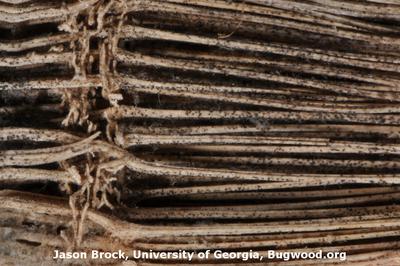Charcoal Stalk Rot
Macrophomina phaseolina
Fungus
In a Nutshell
- Black discoloration of stem's internal tissues.
- Charred appearance.
- Hard fibrous tissues with black specks inside the internodes.
- Premature plant ripening.
- Yellowing and wilting of leaves.
Can also be found in
Symptoms
This soil-borne fungus invades roots at the seedling stage and gradually finds its way to the stems, apparently without symptoms. Later on, mature stems show a black discoloration of their internal tissues that give them a charred appearance, thereby the name. The rot slowly colonizes the vascular tissue, and hard fibrous tissues with black fungal specks are visible between the internodes. The destruction of transport tissues leads to symptoms similar to water deficiency. Plants ripen prematurely and have weak stalks, causing breakage or lodging. Upper leaves first become yellow and then dry out. Brown, water-soaked lesions are present on the roots. In cases of strong infection, more than 50% of plants can break.
Recommendations

Organic Control
Organic treatments such as farmyard manure, neem oil extracts and mustard cake can be used to control Macrophomina diseases. Soil amendment with pearl millet and weed-based composts can lead to a decrease in soil population of the fungus of 20-40%. Soil application of Trichoderma viride (5 kg enriched on 250 kg of vermicompost or FYM) at the time of sowing also helps.

Chemical Control
Always consider an integrated approach with preventive measures and biological treatments if available. Foliar application of fungicides is not effective, as damage has already occurred when the first symptoms occur. Fungicide-treated seeds (with mancozeb for example) may offer protection during seedling growth. The application of 80 kg/ha of MOP in two splits also help to fortify plants and make them more tolerant to this fungus.
What caused it?
This disease is caused by the fungus Macrophomina phaseolina, which thrives in hot and dry environments. It overwinters for periods of up to three years on host crop residues or in the soil. The infection of roots and transport tissue of the stem leads to an impairment of the transport of water and nutrients, thereby the drying of the upper parts of the plant, the premature ripening and the weak stalks. Further favorable conditions for the spreading of the fungus are provided by insects, damaged roots and shoots as well as other plant diseases. Symptoms are are worsened during drought, elevated soil temperatures (over 28°C) and excessive fertilization at later stages of plant growth.
Preventive Measures
- Grow drought tolerant varieties.
- Plant lodging-resistant varieties.
- Adjust the sowing date so that the post-flowering stage is not in the driest part of the growing season.
- Use wider spacing between the plants.
- Maintain good soil moisture through irrigation, especially during the post-flowering period.
- Ensure balanced fertilization and avoid excessive nitrogen use.
- Harvest early to avoid major yield losses.
- Rotate with non-host crops such as small wheat, oats, rice, barley and rye for three years.
- Plan a deep summer plowing to reduce the pathogen inoculum in the soil.
- This may help decrease the population of the fungus in the soil.
- Solarization of soil or a longer fallow after tillage may also be effective.
- In endemic areas farmers are advised to incorporate green manure in soil before sowing of maize.



